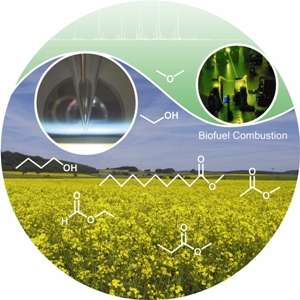May 17 2010
Understanding the key elements of biofuel combustion is an important step toward insightful selection of next-generation alternative fuels.
And that’s exactly what researchers at Sandia and Lawrence Livermore national laboratories are doing.
The journal Angewandte Chemie devotes its May 10 cover to a paper co-authored by Sandia’s Nils Hansen and Lawrence Livermore’s Charles Westbrook, which examines the essential elements of biofuel combustion.
 Cover image of the May 10 Angewandte Chemie publication.
Cover image of the May 10 Angewandte Chemie publication.
The paper, “Biofuel combustion chemistry: from ethanol to biodiesel,” examines the combustion chemistry of compounds that constitute typical biofuels, including alcohols, ethers and esters.
Biofuels, such as ethanol, biobutanol and biodiesel, are of increasing interest as alternatives to petroleum-based transportation fuels. According to Hansen and Westbrook, however, little research has been done on the vastly diverse and complex chemical reaction networks of biofuel combustion.
In general, the term biofuel is associated with only a few select chemical compounds, especially ethanol (used exclusively as a gasoline replacement in spark-ignition engines) and very large methyl esters in biodiesel (used as a diesel fuel replacement in diesel engines). The biofuels are oxygenated fuels, which distinguishes them from hydrocarbons in conventional petroleum-based fuels.
While much discussion surrounding biofuels has emphasized the process to make these alternative fuels and fuel additives, Hansen and Westbrook are the first to examine the characteristic aspects of the chemical pathways in the combustion of potential biofuels.
In collaboration with an international research team representing Germany, China and the U.S., Westbrook, Hansen and former Sandia post-doctoral student Tina Kasper used a combination of laser spectroscopy, mass spectrometry and flame chemistry modeling to explore the decomposition and oxidation mechanisms of certain biofuels and the formation of harmful or toxic emissions. Hansen’s experiments were conducted in part at the Chemical Dynamics Beamline of the Advanced Light Source at the Lawrence Berkeley National Laboratory.
To understand the associated combustion reactions and to identify recurring reaction patterns, Hansen and Westbrook agreed, it is important to study prototypical variants of potential biofuels.
Their study was funded in part by the Department of Energy’s Office of Science, which supports fundamental research, including research aimed at understanding, predicting and ultimately controlling matter and energy at the electronic, atomic and molecular levels in order to provide the foundations for new energy technologies and to support DOE missions in energy, environment and national security.